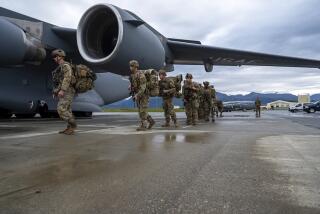Missile Subs Reportedly Being Repositioned in Safer Zone : Key Shift in Soviet Navy’s ‘Arctic Strategy’ Seen
- Share via
KIRKENES, Norway — To the north of this tiny port on the Soviet border is the Barents Sea, and an important shift in Soviet naval strategy is reportedly under way there.
Senior Norwegian and NATO officers believe that the Soviet navy is pursuing a new “Arctic strategy,” repositioning its missile submarines in the Barents Sea far from the North Atlantic and the U.S. coastline.
Further, these officials say, surface units of the Soviet Northern Fleet, based just east of here at the Soviet city of Murmansk, are staying closer to home and are not venturing into the North Atlantic nearly as often as in the past.
“Our intelligence suggests that their Typhoon and Delta class submarines are not moving out into the Atlantic but are remaining north of the Kola Peninsula,” Norwegian Defense Minister Johan Jorgen Holst said in a recent interview. “And it looks as though the surface fleet may be remaining in the Barents Sea to protect the ballistic missile submarines on patrol there.
“If so, this would signify an important change in Soviet naval strategy. The Arctic would be the major focus of operations. We still don’t know whether this shift in deployment is temporary or permanent.”
Under the late Adm. S. G. Gorshkov, the father of the modern Soviet navy, Soviet warships showed the flag around the world, often for purely political reasons.
Key Is Northern Fleet
The Soviet navy is divided into four fleets: the Northern, the Baltic Sea, the Black Sea and Pacific. The Northern Fleet is the most important, because in wartime the Baltic and Black Sea fleets could easily be bottled up by North Atlantic Treaty Organization forces.
The Northern Fleet is based at Murmansk on the Kola Peninsula, which is believed to be the world’s largest naval and nuclear weapons complex. Two-thirds of the Soviet missile submarine force is based there.
In concentrating on protecting the missile submarines, Norwegian officials suggest that the Soviets may be reducing its long-range naval operations. Whether this is for strategic or economic reasons is not altogether clear.
“It could be that we are simply seeing economy moves, with the navy restricted mainly to the Barents Sea,” Defense Minister Holst said. “But Adm. Gorshkov developed his global naval strategy under Leonid Brezhnev (the late Soviet leader), and it may be that Mikhail Gorbachev (the present leader) wants to create a different naval strategy.”
Relying on ‘Boomers’
The Soviets now seem to be relying mainly on the offensive strength of their long-range-missile submarines, known as “boomers” from the abbreviation BM, for “ballistic missile.” These vessels can submerge in the Barents Sea or under the Arctic icecap and be protected there by attack submarines and surface vessels.
In their own front yard, so to speak, the submarines are close to the Murmansk facilities. They can be quickly and easily resupplied, and they do not have to run the risk of passing through the heavily defended waters on either side of Iceland to get out into the Atlantic.
The crucial importance of the region--the Barents Sea, the North Cape area of Norway and the Soviet Union’s Kola Peninsula--is apparent on the map. From here Soviet missiles can reach much of North America--2,500 cities, as far south as San Diego--and all of Western Europe.
In terms of targeting, the submarine-borne missiles can be regarded as a replacement for the intermediate-range missiles that are being scrapped under the U.S-Soviet Intermediate-range Nuclear Forces treaty.
Ringed With Installations
For this reason, Kirkenes is ringed with electronic intelligence installations, and P-3 Orion reconnaissance aircraft fly continuous missions over the Barents Sea and out over the Arctic Ocean.
Naval and air forces of NATO countries and the Soviet Union play a deadly serious game of hide-and-seek, with Western Alliance ships and planes trying to keep track of the Soviet “boomers” and their protective units.
Norway’s major air and naval bases are to the west of here. They are controlled by the Norwegian Northern Command at Bodo, north of the Arctic Circle, which in wartime would form part of the NATO command known as Allied Forces Northern Europe.
“The key to our defense is rapid reinforcement,” Vice Adm. Torolf Rein, commander of Allied Forces, North Norway, said at his headquarters outside Bodo.
The Norwegians point out that although they have only 4 million people, they have a large area to defend. But NATO strategy calls for the rapid reinforcement of northern Norway by U.S. Marines and Canadian and German forces.
Further, the U.S. Strike Fleet, with a carrier battle group, is slated for rapid deployment in case of trouble, and it regularly takes part in exercises in this region.
“Our Orion planes have come up with the first photos of new Soviet hardware,” Adm. Rein said. “We worry about their submarines. They dive deeper and faster and are getting quieter and harder to find. This new strategy seems to call for their attack submarines to protect the missile boats, but they would probably go after the American carriers, if it came to that.”
Defense Minister Holst said: “We can’t really rely on glasnost to solve our defense problems. We see no slackening of Soviet military activity up north.
“We recognize that Norway is a front-line NATO state, the only one except Turkey with a common border (with the Soviet Union). So we don’t attempt to challenge the Russians. But we will defend our country, and therefore, we are involved in a delicate balancing act--between deterrence and reassurance.”
More to Read
Sign up for Essential California
The most important California stories and recommendations in your inbox every morning.
You may occasionally receive promotional content from the Los Angeles Times.













